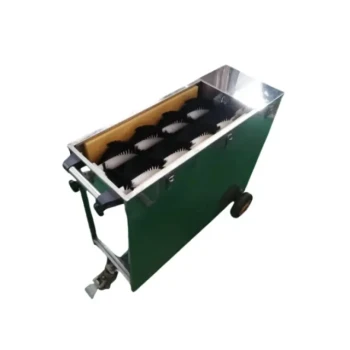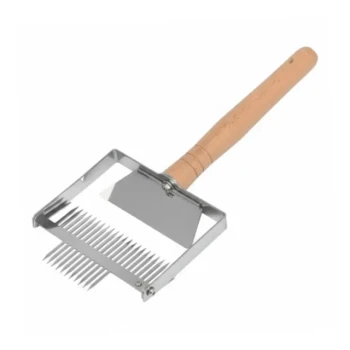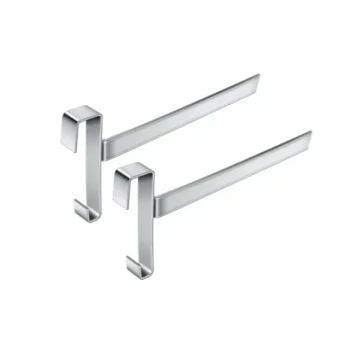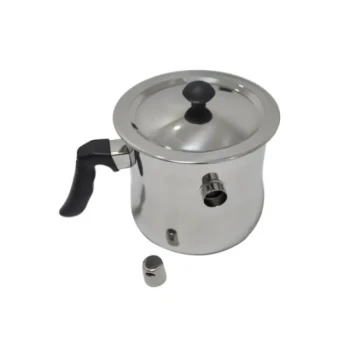In short, your bees are removing larvae because they are performing a crucial act of self-preservation. This hygienic behavior is triggered when the larvae are dead, diseased, infested with pests, or when the colony lacks the resources to support them. It is a vital signal that something inside your hive requires your immediate attention.
Your bees are expert diagnosticians. When you see them removing larvae, they are not just "cleaning house"—they are sending a clear message about a specific threat to their survival, whether it's disease, pests, or starvation.
Diagnosing the Root Cause
Observing bees removing brood can be alarming, but it's a symptom with a limited set of causes. By methodically investigating the possibilities, you can determine the correct course of action.
The Positive: Strong Hygienic Genetics
Sometimes, removing larvae is a sign of a strong, healthy colony. This trait, known as Hygienic Behavior, means the worker bees can detect and remove pupae that are diseased or infested with Varroa mites.
Colonies with these genetics are more resilient and better able to manage health threats on their own. Seeing a few ejected larvae in an otherwise thriving hive can simply indicate your bees are doing their job well.
The Threat: Pests and Diseases
More often, larvae removal is a sign of a problem that has reached a critical threshold.
- Varroa Mites: This is the most common and serious cause. Varroa mites reproduce under the capped brood. Hygienic bees detect the infested pupae, uncap the cell, and remove them. This defensive action often results in a "pepper pot" or spotty brood pattern and is a red flag for a high mite load.
- Chalkbrood: This is a fungal disease that infects larvae, which then die and harden into white or greyish-black "mummies." You will see these chalky pellets being removed by the bees or accumulating on the bottom board.
- Foulbrood (American or European): These are serious bacterial diseases. Infected larvae die, turning brown and eventually decomposing. The bees will attempt to remove them, but these diseases require immediate and specific management to prevent colony death and spread.
The Environment: External Stressors
The colony's health is directly tied to its environment. A sudden change can force the bees to make difficult choices.
- Chilled Brood: If a sudden cold snap occurs, a smaller colony may not be able to generate enough heat to keep all of the brood warm. The larvae on the outside edges of the frame will die from the cold, and the bees will remove them once the temperature rises.
- Starvation: A lack of nectar (carbohydrates) or pollen (protein) can cause severe nutritional stress. To ensure the survival of the queen and the remaining workers, the colony may cannibalize or eject the youngest larvae, which require the most resources.
Understanding the Trade-offs and Common Pitfalls
Interpreting this behavior correctly is critical. A misdiagnosis can lead to the wrong treatment, or worse, no treatment at all.
A Symptom, Not the Disease
Remember that removing larvae is a symptom, not the root problem. Treating for chalkbrood when the real issue is a massive Varroa mite infestation will not save your hive. Your primary goal is to identify the underlying cause.
The Risk of Inaction
Do not assume this is just "normal cleaning." While it can be, it is more often an early warning sign. A high Varroa mite population left unchecked is a primary driver of winter colony losses. Ignoring the signs of starvation or disease can lead to a rapid collapse.
Scale Matters
The quantity and location of removed larvae provide important clues. A few larvae on the landing board of a strong hive might be normal. Seeing dozens, or observing large, empty patches within the brood frames, signals a significant problem that requires an immediate and thorough hive inspection.
Making the Right Diagnosis and Taking Action
Use your observations to guide your response. A methodical inspection will lead you to the right solution.
- If you see a few removed larvae but the brood pattern is solid and food stores are high: This is likely normal hygienic behavior. Continue to monitor the hive during regular inspections.
- If you see a spotty brood pattern and bees with deformed wings: Your first suspect must be Varroa mites. Perform a mite count (sugar roll or alcohol wash) to determine the infestation level and treat if necessary.
- If you find hard, white or black "mummies" in cells or on the bottom board: This indicates chalkbrood. Improve ventilation and consider requeening if the problem persists, as the trait can be genetic.
- If you see widespread larvae removal on the frame edges after cold weather: This is likely chilled brood. If the colony is small, consider reducing its hive space to make it easier to keep the brood warm.
- If the hive feels light and you see minimal stored honey or pollen: The bees are starving. Immediately provide emergency feeding with 1:1 sugar syrup and a pollen patty.
Observing your hive's behavior is the key to shifting from a reactive to a proactive beekeeper, ready to support your colony when it needs you most.
Summary Table:
| Cause of Larvae Removal | Key Signs | Recommended Action |
|---|---|---|
| Varroa Mites | Spotty brood pattern, bees with deformed wings | Perform a mite count and treat if necessary |
| Chalkbrood | Hard, white/grey larval 'mummies' in cells | Improve hive ventilation; consider requeening |
| Starvation | Light hive, minimal honey/pollen stores | Provide emergency feeding (sugar syrup, pollen patty) |
| Chilled Brood | Larvae removal on frame edges after cold snap | Reduce hive space for smaller colonies |
| Hygienic Behavior | A few larvae removed; strong, healthy colony otherwise | Monitor during regular inspections; a positive sign |
Protect Your Apiary with the Right Equipment
Seeing your bees remove larvae is a stressful sign that demands a swift, informed response. Equipping yourself with the right tools—from mite testing kits to essential feeding supplies—is the first step to effective hive management.
HONESTBEE supplies commercial apiaries and beekeeping equipment distributors with the durable, wholesale-priced supplies needed to maintain healthy, productive colonies. From ventilation components to help manage chalkbrood to feeding systems for emergency support, our focus is on supporting your operation's success and resilience.
Don't let a symptom become a crisis. Ensure you have the equipment to act decisively. Contact HONESTBEE today to discuss your wholesale needs and how our products can help you safeguard your investment.
Related Products
- Adjustable Formic and Acetic Acid Dispenser for Bee Mite Treatment
- Varroa Easy Check Mite Tester Kit Counter Alcohol Wash Jar
- Economy Galvanized Beekeeping Honey Bee Smoker for Wholesale
- Professional Bee Smoker with Elongated Spout and Durable Bellows for Beekeeping
- Professional Galvanized Hive Strap with Secure Locking Buckle for Beekeeping
People Also Ask
- Why is it important to assess both current colony size and growth potential? Master Proactive Hive Management
- What is Varroa Mite Syndrome (VMS)? Recognize the Final Stage of Colony Collapse
- How can beekeepers ensure their hives survive the winter? A Guide to Colony Survival
- How can beekeepers prevent resistant mites from gaining a foothold? Master Treatment Rotation for Long-Term Colony Health
- What should be done to manage a beehive in spring? Essential Steps for a Strong, Productive Hive



















